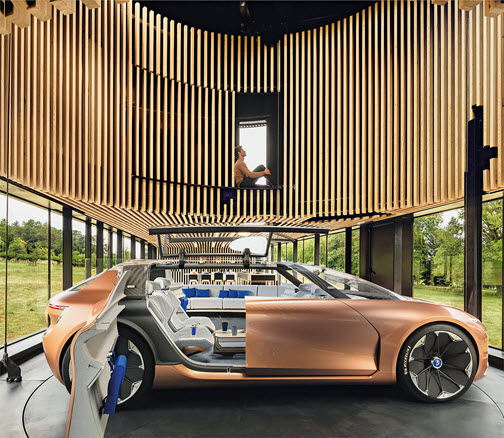This article appeared in our 2018 annual report. Click here to read the full document.
From lifecycle to the cycle of life
Designing the mobility of the future means adopting a sustainable approach that takes into account the whole product lifecycle. It also means putting people at the heart of vehicle design, to provide new experiences and reinvent the way people use vehicles. During Dassault Systèmes’ Design for Life conferences – part of Milan Design Week 2018 – the heads of design at two of the world’s leading carmakers explained their approach. Excerpts from their talks are presented here.
Adopting a holistic view of the product
Daniela Bohlinger, Head of Sustainability in Design, BMW Group
When we talk about design, customers tend to think only about the aspects they can see. But when sustainability comes into play, we also need to take into account the hidden aspects of design. What processes are involved in making the product? What materials are used? It’s not just about designing a car; we need to adopt a holistic view of the product. We started to do this for the first time with the BMW i3, an electric city car. We worked on the materials used, the logistics chain, the production method and end-of-life processing, calculating the carbon footprint at each stage of the product lifecycle. In our recycling center, where we recover materials and put them back into the circular economy, we are seeing that electric mobility is creating new challenges. This is why end-of-life processing needs to be factored in right from the design stage. We don’t just need to think about how a car is dismantled, but also how the various materials are interconnected. The whole design process needs to be rethought, a major cultural change that must be driven by the company’s head management.

Embracing disruption
How can we improve a product’s carbon footprint? First, by reducing; if we don’t manufacture it, it has no carbon footprint, which also explains the appeal of using recycled materials. Reducing weight is also attractive for two reasons. If we use less material in the manufacturing process and also during the vehicle’s life, fuel and electricity consumption is reduced because there is less mass to move. However, to really change the paradigm, we have to embrace disruption and not just improve what we already have. If we want to design something radically new, it’s much easier to start from a blank slate. So for the i3’s dashboard we used kenaf, a plant that belongs to the jute family, and this considerably reduced the car’s carbon footprint. That decision was the result of a collaborative, iterative approach involving our design, supply chain management and lifecycle analysis departments.
A more autonomous, electric and connected world
Laurens van den Acker, Senior Vice President, Corporate Design, Renault
The design strategy is very important because it conveys a company’s brand values, what the company really wants to be. At Renault, people are at the heart of our vehicle design and we aim to ensure that the types of vehicles we produce connect with the changing needs of drivers. This is what we call the cycle of life.

Two of our concept cars demonstrate this approach. The first, Symbioz, reflects an integrated approach to personal mobility in which the car is part of your ecosystem, just like your home, your smartphone and all the other objects around you. The car connects and shares information, but also can exchange energy to recharge itself or other devices. Symbioz takes us into a more autonomous, electric and connected world. It also revolutionizes the way a car is used. You can choose either to drive the car or be driven. If you switch to fully autonomous mode, the steering wheel moves back and you can use the screen to watch a film. The car becomes a sort of lounge on wheels, almost an extension of your home!
Connected to the city
The second concept car is designed as a service. It requires no driver, has no steering wheel or pedals, and you can arrange to be picked up via your smartphone at any time. This is uncharted territory. Is a driverless car still a car? Is it a piece of architecture? Or is it a part of the city on four wheels?
The vehicle is based on an electric platform, on which several variations are possible. It is autonomous, using LiDAR, radar and sensor technology to ensure a constant connection with its environment. Because it is self-driving, it opens up mobility for the greatest number of people, and it has been ergonomically designed to make it easy for anyone to use. For example, you don’t need to bend down to enter the car; you enter from the front. Inside, the environment is highly social. There’s no need for screens because passengers have their smartphones, but the car is transparent and melts into the city. It’s possible to imagine this vehicle becoming as iconic as the London black cab or the New York yellow taxi. We don’t pretend that we have all the answers when it comes to the mobility of the future: these concept cars are an opportunity to foster debate, to experiment, and even to make some mistakes. This open, free and bold approach to the mobility of the future is intended to broaden the scope of what is possible, and to help us design a better way of living.


